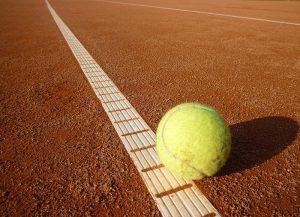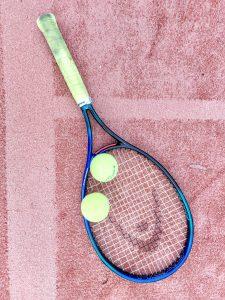We may earn money or products from the companies mentioned in this post.
Introduction

Playing tennis in wet conditions can present a unique set of challenges for both amateurs and professionals alike Often referred to as “wet tennis,” this variation of the sport occurs when rain or other forms of precipitation make the court surface slick and unpredictable Understanding the nuances of wet tennis is crucial for players looking to adapt their gameplay and strategy to these less-than-ideal conditions
Definition of Wet Tennis
Wet tennis refers to playing the sport on a court that has been affected by moisture, such as rainwater or dew This moisture can significantly alter the playing surface, making it slippery and affecting ball bounce and speed Unlike dry conditions where players can rely on consistent footing and predictable ball behavior, wet tennis introduces an element of unpredictability that requires quick thinking and adaptability
-
Differences between Wet and Dry Tennis:
In dry conditions, players can expect a more reliable bounce from the balls, allowing them to anticipate shots with greater accuracy However, in wet tennis, the moisture on the court causes balls to skid rather than bounce consistently This makes it challenging to time shots correctly, adding an extra layer of difficulty
Importance of Understanding the Concept
Recognizing how wet conditions impact gameplay is essential for any serious tennis player By understanding the unique challenges posed by wet tennis, players can adjust their strategies accordingly
-
Effects on Gameplay and Strategy:
Wet courts require players to be more cautious with movement due to reduced traction Rapid direction changes become riskier as there is an increased likelihood of slipping or losing balance Additionally, serves may not have their usual bite due to decreased grip between racquet strings and damp balls -
Safety Concerns for Players:
Beyond the impact on gameplay, wet tennis also raises safety concerns for players Slippery courts increase the risk of falls and injuries, making it crucial for players to exercise caution and employ proper footwork techniques to minimize the chances of accidents
Understanding the intricacies of wet tennis allows players to approach these conditions with a strategy that maximizes their performance while prioritizing safety By adapting their game plan and adjusting their movements, players can navigate the challenges posed by wet courts and continue to enjoy the sport even in less-than-ideal weather conditions
The Impact of Weather Conditions on Tennis Courts

When it comes to the game of tennis, weather conditions can play a significant role in the overall playing experience One particular aspect that can greatly affect the game is rain and how it impacts different court surfaces
How Rain Affects Different Court Surfaces
1 Clay Courts
Clay courts are known for their unique characteristics, and when rain comes into play, it can drastically alter the surface dynamics The clay absorbs water, leading to a change in surface texture As a result, the ball speed and movement become slower, requiring players to adjust their strategies accordingly
Moreover, the increased moisture on clay courts poses an added risk of injury as the surface becomes slippery Players need to be extra cautious with their footwork to avoid any unfortunate slips or falls
2 Hard Courts
On hard courts, rain can create its own set of challenges Puddles may form on the surface, creating uneven playing conditions for players These puddles not only disrupt gameplay but also increase the likelihood of accidents or injuries if players accidentally step into them
The good news is that hard courts tend to have a quicker drying time compared to clay courts due to their solid nature This allows for faster resumption of play once the rain stops and helps minimize any potential disruptions caused by wet conditions
The Role of Humidity in Wet Tennis Conditions
In addition to rain itself, humidity also plays a crucial role in wet tennis conditions High humidity levels can make it challenging for players to manage sweat effectively during matches or practice sessions
Sweat management becomes crucial as excessive perspiration can lead to discomfort and affect grip stability on rackets and shoes Players need to find ways to keep their hands dry and maintain a secure hold on the racket, ensuring optimal performance and reducing the risk of unforced errors
Overall, weather conditions have a significant impact on tennis courts, influencing factors such as surface texture, ball speed, movement, player safety, and sweat management Being aware of these effects can help both players and court managers make appropriate adjustments to ensure an enjoyable and safe playing experience for all
Adapting to playing in wet conditions

Playing tennis in wet conditions can be challenging, but with the right strategies and adjustments, players can still perform at their best Here are some ways players can adapt their game when faced with rain-soaked courts:
1 Choosing the right footwear
When playing on a wet court, selecting the appropriate footwear is crucial Players should consider two main factors: grip and water resistance The shoes should provide excellent traction to prevent slipping on the slick surface Additionally, having water-resistant features will help keep the feet dry and maintain comfort throughout the match
2 Changing hitting techniques
In damp conditions, controlling the ball becomes more challenging due to reduced bounce and slower play To adapt, players need to adjust their hitting techniques They should focus on generating more topspin to give the ball an extra kick off the court surface This will help compensate for the lower bounce and ensure better control during shots
3 Tactical adjustments
Playing conservatively is often a smart approach when dealing with wet conditions Minimizing unforced errors becomes crucial as any misjudgment or mistimed shot can result in losing valuable points By adopting a more cautious style of play, players can reduce risks and increase their chances of winning points consistently
The role of umpires & tournament officials during wet tennis matches

In wet tennis matches, umpires and tournament officials play a vital role in ensuring fair play and maintaining player safety:
1 Monitoring court safety & playability
Umpires and officials have the responsibility of continuously assessing court conditions during wet weather situations They need to monitor factors such as standing water, slippery spots, or any other hazards that could compromise player safety If the court becomes too dangerous to play on, they may decide to suspend or delay the match until conditions improve
2 Deciding when to suspend or resume play
Determining when to halt or resume a match is a challenging decision for umpires and tournament officials They need to consider various factors, including the intensity of rain, court drainage capabilities, and player welfare Ultimately, their judgment ensures fair gameplay while prioritizing the safety of all participants
Adapting to playing in wet conditions requires players to make strategic adjustments and rely on their skills under challenging circumstances Meanwhile, umpires and officials have a crucial role in maintaining fair play and ensuring player safety during rainy tennis matches
Preventing injuries and maintaining optimal performance during wet tennis matches

When it comes to playing tennis in wet conditions, taking the necessary precautions can help prevent injuries and maintain optimal performance One key aspect is incorporating warm-up routines specifically tailored for these conditions
Warm-up routines specific for wet conditions
In order to avoid potential injuries, dynamic stretching exercises should be included in your pre-match warm-up routine These exercises help improve flexibility and increase blood flow to the muscles, reducing the risk of strains or pulls
Additionally, adapting your cardio exercises to account for slippery surfaces is crucial Incorporating lateral movements and quick direction changes can help enhance stability and balance on the court
Techniques to maintain grip on racket handle
Maintaining a secure grip on your racket handle is essential when playing in wet conditions One effective technique is choosing the right overgrips and accessories that offer enhanced traction even when exposed to moisture
Furthermore, frequent use of a towel to dry both your hands and equipment between points can significantly improve grip stability This simple yet effective practice ensures that your hands remain dry, allowing for better control over your shots
Post-match recovery tips after playing in wet conditions
After playing in wet conditions, it’s important to address any strains or injuries promptly Ignoring discomfort or pain may lead to more serious issues down the line Applying ice packs or using anti-inflammatory creams can help alleviate soreness and reduce inflammation
Resting and allowing your body time to recover is also crucial after intense play in wet conditions Taking breaks between matches or practices, as well as getting enough sleep at night, allows for proper healing and rejuvenation
Useful Links

Sofi Tukker releases latest album, ‘Wet Tennis’ – News
Inside Sofi Tukker’s Colorful & Positive World of ‘WET …
RB Exclusive Interview – Sofi Tukker Talk Wet Tennis, The …
SOFI TUKKER Sophomore Album, ‘Wet Tennis’ Review
Wet Tennis: CDs & Vinyl
Album Review: Sofi Tukker – Wet Tennis – Beats Per Minute
Sofi Tukker – WET TENNIS | Clash Magazine Music News …
Music Review: Sofi Tukker’s “WET TENNIS” Is Consistently …
SOFI TUKKER – Wet Tennis Lyrics
WET TENNIS – Album by Sofi Tukker
MUSIC
Wet Tennis Hoodie | Shop the Sofi Tukker Official Store
Wet Tennis by Sofi Tukker – New on Vinyl
Wet Tennis – Sofi Tukker
Sofi Tukker – Wet Tennis (Picture Disc) [Vinyl]
Sofi Tukker – Wet Tennis – CD
Wet Tennis | Just Dance Wiki – Fandom
SOFI TUKKER’s “WET TENNIS” debuts at #1 on Electronic …






